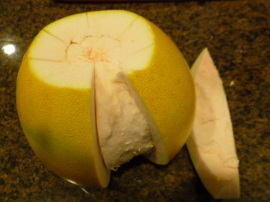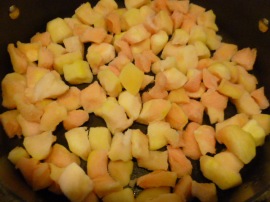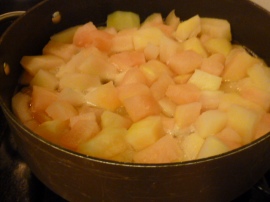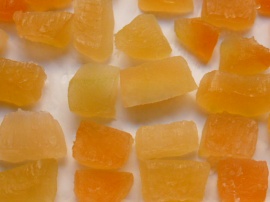The following recipe came from my maternal grandmother, who was raised in the Sephardic Jewish community of Izmir. The making of jams, confitures and sweets was an important part of every household, and the guests were greeted with an assortment of small plates of these delicacies, along with coffee and cold water.
Citrus rinds were also part of the selection, and pomelo, the largest citrus fruit, was used to make the tastiest sweets, as I’ve done here. It was fascinating to watch the peels transform from bitter, spongy and inedible food waste, into addictive shiny and aromatic sweets.
Though the process of making these sweets is a bit lengthy, their wonderful flavor and unique texture is definitely worth it. Try it and enjoy.
Notes:
* It is important to use a large pomelo, with thick rind. The larger, the better.
* While I would prefer using the juicier white pomelo, I could only find pink ones, which is why part of the sweets turned pinkish. If you can find white pomelo, the sweets will end up with a more consistent color.
* Serve the pomelo flesh as is, or use it to prepare sweet-savory salads. A recipe for one can be found HERE.
* Check HERE for a recipe for quince sweets, from the same origin, and HERE for more information about Sephardic cuisine.
Makes: 60-70 sweets
Prep time: 30 minutes
Soaking time: a couple of days, as explained in the recipe
Cooking time: about 1 hour
Drying time: 2-3 days
Ingredients:
1-2 large pomelo, with a thick rind
Sugar (quantity explained in the recipe)
¼ cup fresh lemon juice
1. With a sharp knife, remove the pomelo top. Make eight incisions in the rind, and peel off the sections. With a small sharp knife, remove the greenish zest from each section, and cut into 5-6 pieces. Place in a wide, heavy bottom pot, cover with water and place a plate on top, to prevent the pieces from floating.






2. Bring to the boil over medium-high heat, and cook for 2-3 minutes. Remove from the heat, carefully remove the plate with kitchen tongs (it’s hot!), and drain in a large colander. Pour cold water on to cool. Once cooled, squeeze the spongy pieces (do not worry, they will return to their original shape!) and return to the pot.


3. Once again, cover with water and plate. Keep at room temperature for 5-6 hours, or overnight. Drain and repeat the squeezing/soaking in water twice more. Taste the water squeezed out of one piece, to determine if the rinds are still bitter or not, and if you need to repeat the process. Once the pieces are no longer bitter (a slight bitterness is fine), squeeze them again and measure them in cups.


4. Place the squeezed pieces in wide pot. Add 1 cup sugar and 1½ cups water, for each 1 cup squeezed pieces, and the lemon juice, and mix gently. Cover and keep at room temperature for about 3 hours, until the pieces are plump again, and the sugar dissolved.


5. Mix gently, cover the pot, and bring to the boil over medium-high heat. Cook for 2 minutes. Reduce the heat to medium and cook for 10 minutes. Lower the heat to minimum, uncover the pot and cook for about 30-40 minutes, or until the syrup is completely absorbed in the pieces, and they are transparent and shiny. (Check closely towards the end of the cooking time). Let cool to room temperature.


6. Line a sheet pan with wax paper and place the pieces over it, in one layer, leaving a bit of space between them. Cover loosely with wax paper (to prevent dust). Leave to dry in a cool ventilated place, for 1-2 days, turning the pieces twice, before serving.


7. To keep: arrange the pieces in an air-tight container, separating the layers with wax paper. The sweets will keep, in a cool dark place, for about 2 weeks.





I can only imagine how delicious it is, dear Ronit!
LikeLiked by 2 people
Thank you Dolly. The sweets are so unique and wonderful. It’s worth it to wait a whole year to be able to make them! 🙂
LikeLiked by 2 people
Certainly. We used to spend summers making jams and confitures, to last the whole winter.
LikeLiked by 1 person
Wonderful memories. 🙂
LikeLiked by 1 person
They look mouthwatering. I can imagine that they are also very versatile – you can eat them as they are, or with dark chocolate, or you can use it to refine a cake…
LikeLiked by 2 people
Thank you Karin, I’m glad you liked the recipe. The sweets are so tasty, that they usually disappear soon after making – but you’re right, they can definitely be used in versatile ways. 🙂
LikeLiked by 1 person
Can they be used in baking? This seems a long process just to eat as is.
I make my own candied citrus peel which is beautiful and flavours cakes, biscuits and fruit mince wonderfully. I use orange, lemon and lime.
I will look for pomelo when I next visit the fruit shop. Thankyou. :))
LikeLiked by 2 people
Though I also use candied citrus in baking, I don’t see why “just to eat it” is not worth the effort – quite the contrary! However, of course you can use the sweet in any way you prefer. 🙂
LikeLike
Thankyou for your reply. Of course it is worth making it to eat it but it would be nice if it enhanced my baking flavours as well. I hope I didn’t give the impression that this wasn’t worth making ‘just to eat’. If I ever find this fruit I shall certainly give it a try.
LikeLike
No worries, I totally understand why you would want to use these tasty sweet in any possible way. 🙂
LikeLike
Interesting. When I was a kid my grandmother used to make candied watermelon rinds.
LikeLiked by 2 people
Thank you Blaine, I’m glad the post brought back tasty memories. 🙂
I too make candied watermelon rinds. If interested, check the following link for the recipe.
https://ronitpenso.wordpress.com/2017/06/18/watermelon-rind-preserves/
LikeLiked by 1 person
Very interesting and I’ll bet they are great!
LikeLiked by 1 person
Thank you Kendall, I’m glad you liked the recipe. The sweets have wonderful flavor and texture. 🙂
LikeLiked by 1 person
Welcome!
LikeLiked by 1 person
I love Pomelo and only discovered them a couple of years ago. I love grapefruit and this, of course, is a relative. I don’t know if I’d go through this process or not, but I am intrigued. Do you know, would it work to freeze the fresh pieces until I’ve eaten a few pomelos, and then thaw them out and do this?
LikeLiked by 1 person
Thank you Lisa, I’m glad you liked the recipe. If you love grapefruit, I’m sure you’ll enjoy pomelo as well.
Freezing the peel, can somewhat change the texture, so it’s best to avoid that. 🙂
LikeLiked by 1 person
Hey, I freeze almost everything. I may give it a try 😊 But you are right, it might change the texture.
LikeLiked by 1 person
Such a lovely color and must be so yummy!
LikeLiked by 2 people
Thank you Ursula, I’m glad you liked the recipe. These sweets are so tasty, and have wonderful texture and aroma. 🙂
LikeLiked by 1 person
Looks delicious – nice that the recipe is from your maternal grandmother. I’ve candied a few things but never a Pomelo. I like the colors and I know I couldn’t stop eating just one, two, three… 🙂
LikeLiked by 1 person
I’m with you on that Judi – the sweets are so tasty, it’s very hard to stop at only one…
I enjoy documenting such recipes whenever I can. Most are quite time consuming, but well worth the effort. 🙂
LikeLike
Looks intriguing. Perhaps I may try it sometime. I’m not aware of its availability where I live. 👁👁🍃
LikeLiked by 1 person
Thank you Gail, I’m glad you liked the recipe. Unfortunately, pomeloes are not as popular as other citrus fruits, and many times I find much smaller ones, that are not suitable for making these sweets. I would also prefer white one, but compromised on the less juicy pink variety. Hope you’ll be able to find one. 🙂
LikeLiked by 1 person
I’ll keep my eyes open. Thanks very much. 🙏🏻
LikeLiked by 1 person
Good luck! 🙂
LikeLiked by 1 person
Fascinating! I’ve only had candied peel, but not the fleshy part! Very interesting.
LikeLiked by 1 person
Thank you Mimi, I’m glad you liked the recipe. Unlike most citrus fruits, the pomelo rind is much thicker, and has a spongy texture, which absorbs the syrup easily, yet still keeps a fairly soft texture. Highly recommended! 🙂
LikeLiked by 1 person
Huge pomelos are growing here in Thailand the whole year – luckily because I really love them!
I prepared a marmalade, using the flesh and a part of the rind as well: but the greenish part of the zest only. Delicious!
https://felix.kitchen/2017/11/09/pomelo-marmelade/
Is it correct, that you don’t use these thin greenish parts?
In your picture, the fruit looks more like a grapefruit. Are you sure, it is a pomelo? Pomelos are normally not so round, but rather pear-shaped with a dimpled surface…
LikeLiked by 1 person
Lucky you Felix, for having such pomelos at hand!
I can see why you think the one I have here is not a pomelo, but it is. Unfortunately, the type we have here, which is not easy to find, is also less juicy, and most often has a pinkish flesh. But it’s still better than nothing! I’m sure you can get better results with the pomelos you have in Thailand.
As for the greenish zest, I keep it for syrups or to flavor cakes.
Your recipe looks wonderful. I hope to find another nice pomelo and give it a try. Thanks for sharing! 🙂
LikeLiked by 1 person
I like home-made candied fruits, and I never had the patience to try at home. This post motivated me to do so, thanks so much.
LikeLiked by 1 person
Thank you Megala, I’m glad you liked the recipe and that it motivated you to try it. These tasty sweets are definitely worth the effort! 🙂
LikeLiked by 1 person
This is so interesting, I bet this tastes divine 🙂
LikeLiked by 1 person
Thank you Myra, I’m glad you liked the post. The sweets are indeed so tasty. Very addictive! 🙂
LikeLike
I have never had a pomelo but this looks divine!! I love that you’re honoring your Grandmother and sharing a tradition with the rest of us.
LikeLiked by 1 person
Thank you Mollie, I’m glad you liked the recipe. t’s my pleasure to document and share these traditional recipes.
Pomelo, is such a wonderful fruit. Definitely worth seeking. 🙂
LikeLiked by 1 person
I’ve always thought items like this were lovely and genteel!
LikeLiked by 1 person
They do have an old world charm to them. 🙂
LikeLiked by 1 person
Very good!!😊😊😊
LikeLiked by 1 person
Thank you! 🙂
LikeLike
My mouth is watering just reading about these. I love candied citrus rinds.
LikeLiked by 1 person
Thank you Sheryl, I’m glad you liked the recipe. Candied citrus rinds are indeed so wonderful, on the verge of addictive! 🙂
LikeLike
Awesome
LikeLiked by 1 person
Thank you! 🙂
LikeLiked by 1 person
This is just amazing Ronit. I love pomelos but have never used the rind.These candied rinds look delicious! Thanks for the detailed step by step recipe.
LikeLike
Thank you Sandhya, I’m glad you liked the recipe and found the photos helpful. It is amazing to see how the humble rinds transform into such delicate tasty sweets. 🙂
LikeLiked by 1 person
Pomelos have such a thick rind. This is a great way to use the entire fruit. They look beautiful.
LikeLiked by 1 person
Thank you Bob, I’m glad you liked the recipe. The rind is indeed quite thick and it’s quite fascinating to see how it transforms into these delicate tasty sweets. 🙂
LikeLiked by 1 person
wow wonderful to know this recipe.
LikeLiked by 1 person
Thank you NIsha, I’m glad you liked the recipe. The sweets are so tasty! 🙂
LikeLiked by 1 person
I’ve just put my pieces in with sugar for their last room temperature soak. This has been fun, squeezing these little sponges out and then watching them plump right up again with water is entertaining. I has never even heard of pollo before and just chanced upon them on our grocery store’s website, and I’m so glad you wrote this out to share. I candied the zest yesterday while the pith was soaking repeatedly. I may try drying these in my dehydrator. 🙂 Thank you for the instructions!
LikeLiked by 2 people
Thank you for taking the time to update. It’s my pleasure to share and I’m glad to hear you enjoy the process of making these tasty treats. I hope you’ll enjoy them! 🙂
LikeLike
What a wonderful recipe – recipes that are handed down are always the best, and often the most versatile, as they’ve stood the test of time! So special..!
LikeLiked by 1 person
Thank you Emma, I’m glad you liked the recipe. You’re so right, such recipes have been passed for generations for a very good reason! 🙂
LikeLiked by 1 person
when you say to “Drain and repeat the squeezing/soaking in water twice more” do you mean to repeat the 5-6 hour soaking, as well? I want to make sure I am soaking for the appropriate time
LikeLiked by 1 person
Yes, you need to keep soaking and squeezing in the same manner, to get rid of the bitterness. Hope it helps! 🙂
LikeLike
Ronit, these are wonderful! Thank you for introducing me to this recipe. Will definitely make it again.
LikeLiked by 1 person
Thank you Naomi, I’m very glad to hear! 🙂
LikeLiked by 1 person
Lovely recipe. Can you freeze the sweets once they are made? I would love to save some for my son who lives some distance away
LikeLiked by 1 person
Thank you Petal, I’m glad you liked the recipe. I haven’t tried freezing the sweets, as I suspect it can compromise their special texture. However, I think it’s worth trying. I’d be happy to know if you tried and how it came out. Good luck! 🙂
LikeLike
Thanks for the wonderful heritage recipe, Ronit. I happened to have three gigantic pomelos on hand, so I have now made the recipe twice. I also candied the zest that I peeled off the pith.
When I served the candied pith to my friends, they thought it was lokoum (Turkish delight) – I explained what it was and that the recipe is from Izmir, so it is, technically, a Turkish delight 😉
For variety I dipped some of the candied pith (and the candied zest) in dark chocolate – that was very popular! !
LikeLiked by 1 person
Thank you Henry, for this wonderful update. I’m so happy to hear you’ve made these tasty candies, and that you and your friends have enjoyed them.
The texture is indeed somewhat similar to Turkish delight, though, as Izmir was under Greek rule until 1930 (and was called Smyrna), they’re due to at least part of the credit…
I really like the idea of dipping in chocolate, and will give it a try next time.
Thanks again for taking the time to update. Comments like yours make blogging so much more rewarding! 🙂
LikeLike